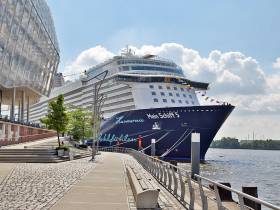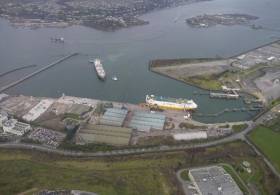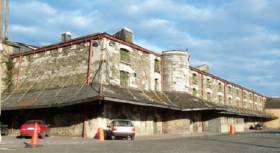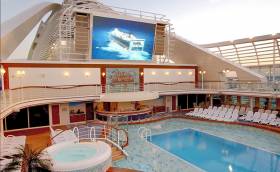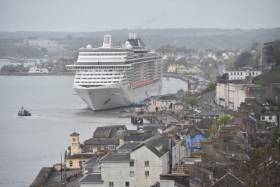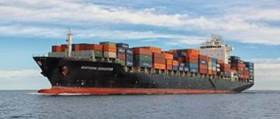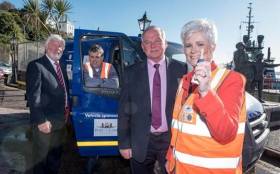Displaying items by tag: port of Cork
Come In Channel No.5 As Irish Ports Await Arrival of Another Big Brand New Cruiseship
#NewestShip – Afloat.ie has tracked another big brand new cruiseship, Mein Schiff 5 that is to make a first call to an Irish port tomorrow, reflecting the growing demand for such visits and related infrastructural developments, writes Jehan Ashmore.
Mein Schiff 5 towering 15 decks and almost 100,000 gross tonnage is TUI Cruises' latest fleet member with a 2,750 passenger capacity that is to make a debut to Dublin Port before dawn.
After her visit to the capital, passengers have no less than 13 restuarants and bistros dining options to choose, before it will be the Port of Cork’s turn to welcome the latest newcomer to Cobh on Saturday. Both Dublin through its new cruise terminal development and Cobh’s upgrade are to meet the berthing requirements of even much larger cruiseships.
Today, Mein Schiff is berthed at the Port of Holyhead from where had arrived from the UK’s premier cruise port of Southampton.
In July, the 295m vessel was named Mein Schiff 5 at a ceremony in Lübeck/Travemünde. It was at nearby Kiel, she sailed across the Baltic Sea for her maiden voyage to Stockholm, calling at Tallinn, St. Petersburg and Helsinki.
The newest addition brings to a total of 14 cruiseships for TUI Group, a hotel and cruise group that was initiated at the end of 2014 and includes the rebranding of the UK operator, Thomson Cruises. Mein Schiff 5 is the Group’s third new build, and in June was handed over 10 days ahead of scheduled at the Meyer Turku shipyard, Finland to subsidiary TUI Cruises.
Like TUI Cruises’ other newbuilds, Meins Schiff 5 is a low-vibration vessel, which uses state of the art technologically that will enhance a pleasant environment for her guests. She has a 280m jogging track and 25m swimming pool.
In terms of operational efficiency, there is 30% less energy consumption and therefore 30% less fuel than other cruiseships of a comparable size.
Towards the end of the construction period, work simultaneously began on the construction of another sister, Mein Schiff 6. Meyer Turku were also involved in the construction of predecessor, Mein Schiff 4 launched in 2014.
In the following year, Mein Schiff 4 made a first call to Dun Laoghaire with an anchorage much closer to the harbour compared to other callers of recent years. The south Dublin Bay port still awaits a planning decision on the controversial cruise-berth to enable such sized ships and even larger to dock within the harbour.
Plans for New €15m Berth to be Cobh’s Quay to Success
#NewBerth - A new €15m deep-water quay in Cobh is in the planning by the Port of Cork, to handle the increasing number of large cruise liners expected to arrive in the near future.
The Irish Examiner writes the port company have confirmed a record 66 liners are already booked to dock in the harbour next year, and the figure could well top 70 as the larger Quantum class vessels may yet announce their intention to visit.
The scheduled 66 ships will carry 170,000 passengers in total and, on average, they are expected to directly spend €73 each while ashore bringing a potential boost of €12.41m to the local economy.
Port of Cork commercial manager Captain Michael McCarthy said the company was planning to reach a target, by 2020, of attracting 75 cruise ships annually but it could be achieved earlier as business prospects are very encouraging.
The newspaper details more about the new cruise-berth here
Boost to Port of Cork With Profits Up 79%
#ProfitsUp - The Port of Cork through increased activity saw profits increase by 79% to almost €4.5m last year, reports the Irish Examiner.
The State-owned company, which oversees port operations in Cork, saw revenue from charges to port users and property rental increase by 12.9% to €29.8m.
Ireland’s second busiest port also reported growth in the volume of goods passing through Cork in 2015 – up 8.6% to 11.02 million tonnes – although there was a slight decrease in the actual number of vessels – down 10 to 1,174.
In its annual report the company welcomed the decision by An Bord Pleanála, last May, to grant planning permission for a €100m redevelopment at Ringaskiddy which it described as a “critical infrastructure project”.
To read more click here
#PortCorkSite - Elected representatives were dismayed to be told yesterday that Cork City Council does not have plans for the historic site, which was once earmarked for a National Diaspora Centre.
The Evening Echo reports that in recent weeks, the Port of Cork listed the 2.9 acre site at the entrance to the city on the market for approximately €7 million. The site includes the old Custom House and the Bonded Warehouses.
It was hoped that a bid may be forthcoming from the local authority in order to transform the site into a critical piece of tourism infrastructure for Cork, though this now seems unlikely.
Officials from City Hall informed councillors at last night’s meeting of Cork City Council that it is ‘not in a position to fund the acquisition’ of the site.
A spokesperson for City Hall told councillors that, “The City Council does not have a plan for the Cork Harbour Commissioners building which is currently for sale on the open market following a decision by the Port of Cork company to put it on the market.
“The City Council is not in a position to fund the acquisition of the property, nor to develop the premises as a maritime or diaspora centre.”
To read further on this story, click here.
Basking Shark Arrives in Cork Harbour For Harbourfest16
Port of Cork posted this picture of the 'biggest' basking shark in Cork Harbour today, presumably enjoying #corkharbourfest16 that includes the Ocean to City race.
Cork’s ‘Caribbean’ Caller Cruises to Capital
#CaribbeanCall - Caribbean Princess of 112,894 tonnes sailed overnight from Cobh, Cork Harbour and made a very early arrival call of 03.30 to Dublin Port this morning, writes Jehan Ashmore.
The Princess Cruises call follows that of another giant MSC Splendida of 137,936 tonnes that made a recent return to the port following a debut to Dublin last season. This year is a record breaking season with 113 calls scheduled and bringing around 180,000 visitors.
At 289m Caribbean Princess may not be the longest ever cruiseship to dock in Dublin Port as demonstrated by the 333m MSC Splendida with up to 4,600 passengers. Today's call of the impressive 'Caribbean' that towers 19 decks alongside Ocean Pier, is one more deck higher than the 'Fantasia' class MSC Splendida.
The 3,142 capacity Caribbean Princess is one of the most frequent class of cruiseships to visit Dublin Port over the last decade. In 2004 the ‘Grand’ class leadship, Grand Princess made an inaugural call which then broke the port record as the first cruiseship to exceed 100,000 gross tonnes.
Princess Cruises is operated by the world’s largest cruise company, the US based Carnival Corporation which among its other subsidiaries includes P&O Cruises. Last year their 700 passenger Adonia called to Cobh last year.
Under a new brand ‘fathom’ the Adonia, made a historic call to Havana, Cuba this month, the first US cruise ship to visit the country in almost four decades.
#BusyCork - Cork's economy writes the Evening Echo, is set to be boosted by cruiseships bringing almost 20,000 passengers and crew expected in a 10-day period.
Port of Cork officials estimate that 13,500 passengers and 5,000 crew will pass through Cobh in a 10-day period, beginning with yesterday’s arrival of the MSC Splendida. The longest cruise ship to ever visit Irish shores (including Dublin Port), at 333 metres llong, brought some 4,600 passengers and crew to Cobh.
The luxurious liner, which has more than a dozen bars and lounges along with four swimming pools, a spa, Turkish baths, squash courts and a Formula 1 simulator across its 18 decks, will return to Cobh next weekend.
In the interim, a further five vessels will dock at Cobh’s cruise terminal. The town will welcome more than 50 ships in total this year, with the cruise liner season running until December 19, bringing a multi-million euro boost to the local economy.
For more on the story, click here.
Afloat.ie has listed the cruise ship list for beyond the next 10 days to include further callers to the end May. Note that not all the cruiseships will berth at Cobh Cruise Terminal but throughout Cork Habour.
For updates to schedules click here.
Port of Cork Lands Trade Coup with Cuba
#CorksCubaCoup - A major coup for the Port of Cork has been achieved in landing a potentially lucrative spot on the first direct freight shipping service from northern Europe to Cuba since economic sanctions were removed on the Caribbean country.
The Irish Examiner writes that Danish shipping giant Maersk — the world’s largest container carrier — began its first ever connection between northern European ports and Cuba last Friday, promising the fastest freight transit times between Europe and the Cuban port of Mariel.
The service will link the ports of Bremerhaven in Germany, Rotterdam, Tilbury in the UK and Cork to Mariel and onto Panama.
Earlier this month, the MV Northern Dedication (pictured above) docked in Port of Cork’s deepwater berth at Ringaskiddy, which Afloat reported on the largest container ship ever to arrive in any Irish port. This forms a weekly scheduled call from Central America to Cork and sees the delivery to Ireland of 75 containers of fresh fruit, mainly comprising Fyffes bananas.
Also this month, Maersk has acted on rising demand from Irish-based customers by starting a new direct service between Dublin and Algeciras in Spain.
For more on the new Cuba service, click here.
At a ceremony in the Port of Cork boardroom this week Chairman of the Port of Cork John Mullins announced Scoil Barra Naofa from Monkstown as the winners of ‘Best Overall Project’ in the Port of Cork Schools Initiative 2016. The schools initiative theme ‘A Day in the Life of a Cruise Passenger Visiting Cork Harbour’ saw twenty seven primary schools from across Cork submit a project. Scoil Barra Naofa made a tremendous effort, cross stitching a wonderful display of tourist attractions around Cork.
A prize for ‘Best Artwork’ was given to Glasheen Boys School for their excellent effort which used a method of wood carving called fretting.
Port of Cork Chairman John Mullins reminded all participating classes that as well as receiving a certificate of participation, every class will be treated to a high speed, fun filled boat trip around Cork Harbour, compliments of the Port of Cork. As an extra special prize, best overall winners Scoil Barra Naofa will go on board a cruise liner in May for a tour of the ship.
Speaking about the schools initiative, the Chairman of the Port of Cork John Mullins said; ‘Massive congratulations to all the participating primary schools and a huge thank you to all the 5th class teachers who put in time and effort into their project.’
He continued: ‘This year’s theme focused on the cruise liner business and in particular encouraged children to understand and appreciate how important tourism is to the Cork region. The standard among the schools was exceptionally high this year and every participating class should be extremely proud of their achievement.’
The Port of Cork Schools Initiative aims to educate 5th class primary school children not only about the Port of Cork but most importantly about Cork Harbour, its rich maritime history and the trade and business connections. The initiative is run annually and this year is the eleventh year of the Port of Cork Schools Initiative.
All projects are currently on display at the Cobh Maritime Building, located on the platform at Cobh Railway Station. Cobh Maritime Building is open to the public daily from 11am to 4pm.
Port of Cork Acknowledges Cobh Tidy Towns Commitment
The commitment and effort of the Cobh Tidy Town volunteers in maintaining the landscape of Cobh town was acknowledged by the Port of Cork today when they handed over the keys to a small pickup truck. The truck will enable the Cobh Tidy Towns team to improve their service within the area and carry out bigger clean up and landscaping jobs around the town. As well as carrying tools and equipment used for clean ups, grass cutting and tending to flower displays, the truck will also be used to transport the rubbish collected by the tidy towns team which up until now was being put into the back of volunteers’ cars.
The Port of Cork is very proud of the Cobh Tidy Towns team, who go to great lengths to ensure the positive image of Cobh Town is maintained for locals and visitors, many of whom are visiting by cruise ship.
Brendan Keating, Chief Executive of the Port of Cork who officially handed over the keys of the truck said: “Cobh Tidy Towns have been working to create a positive change in Cobh for many years and we believe they have achieved their goals. Cobh Tidy Town works tirelessly to ensure the town looks in great shape all year round and we know the appearance of the town can leave a lasting impression for visitors and is so important when aiming to attract new visitors and return visitors.”
He continued: “The Port of Cork is proud to acknowledge the team effort of the volunteers and we hope the truck will show our appreciation to the team and also make the day to day operations a lot easier.”
Cobh won its first bronze medal in the National Tidy Towns competition in 2011, placing it at 103 in the country. A silver medal win in 2012, 2013 and 2014 was followed by a Gold Medal win for Cobh in 2015.
Ruth Ring, Chairperson of Cobh Tidy Towns said: “We are absolutely delighted to receive this truck from the Port of Cork today. We are so proud of Cobh and we work with the community to ensure our town looks at its best all year round. Thanks to the generosity of the Port of Cork our volunteers will be able to work more efficiently to keep Cobh a beautiful place to live in, work in and to visit”


























